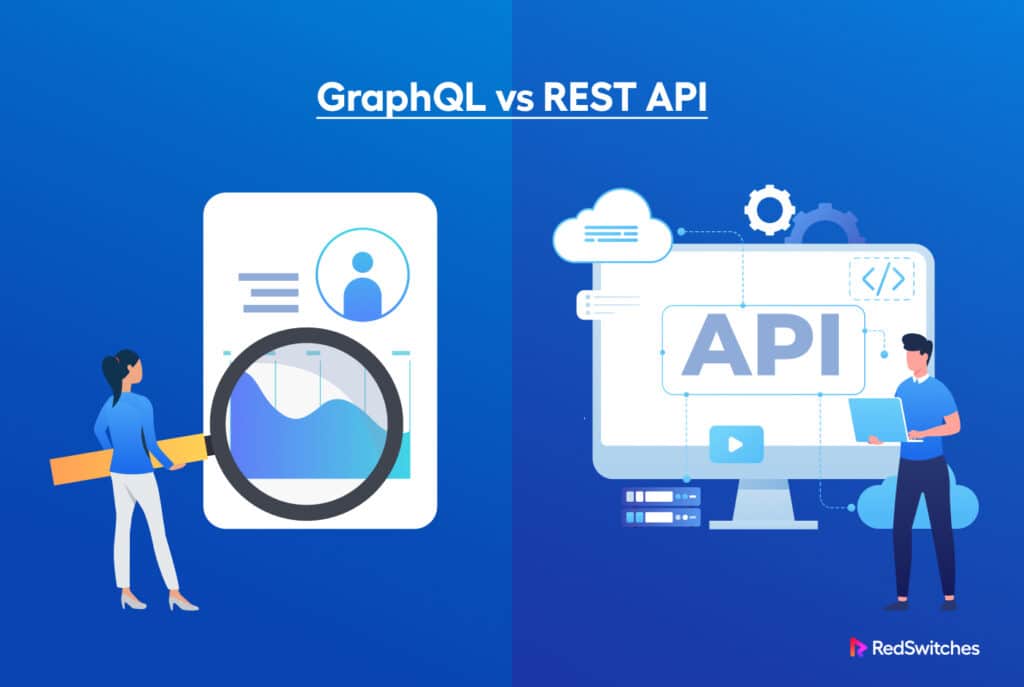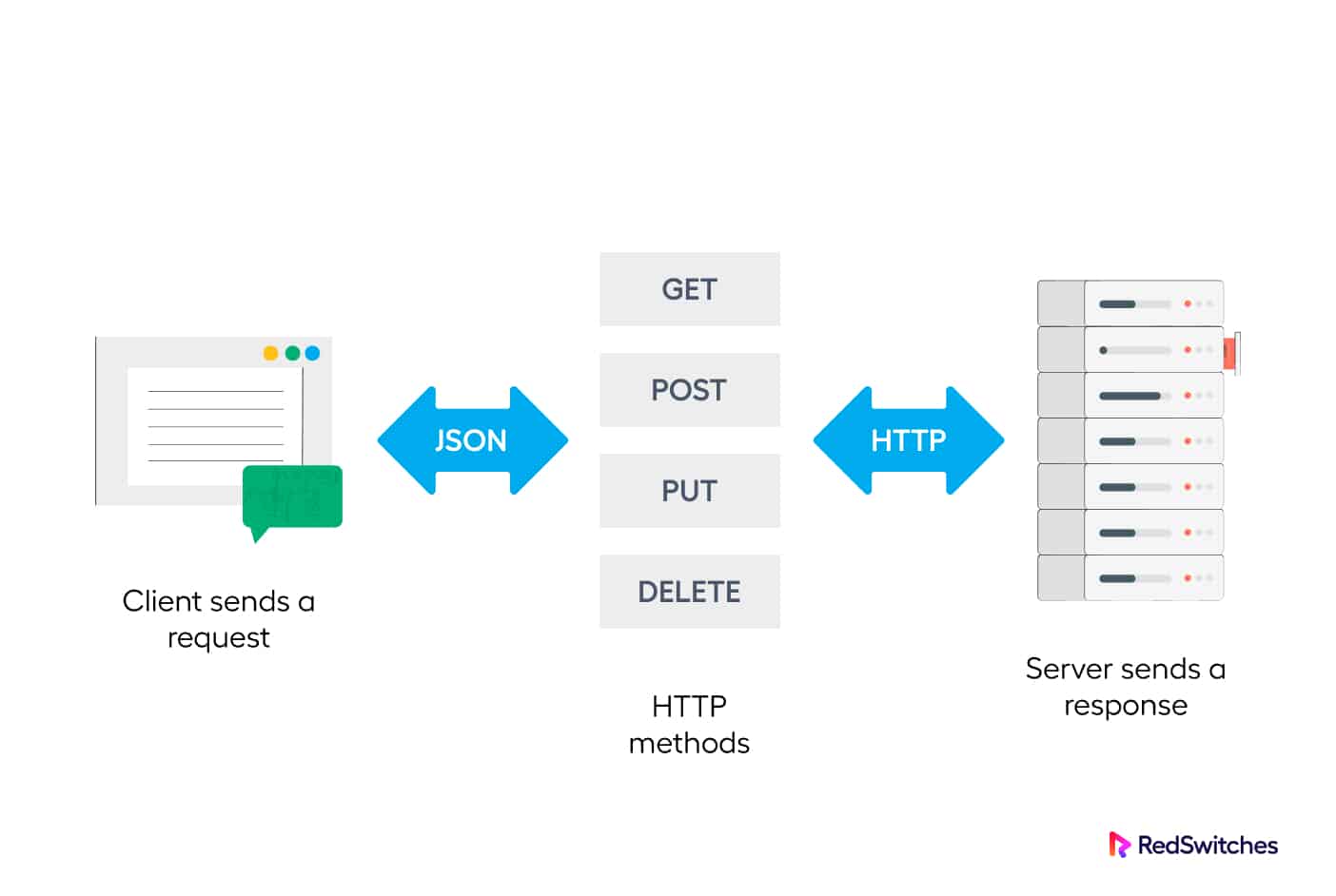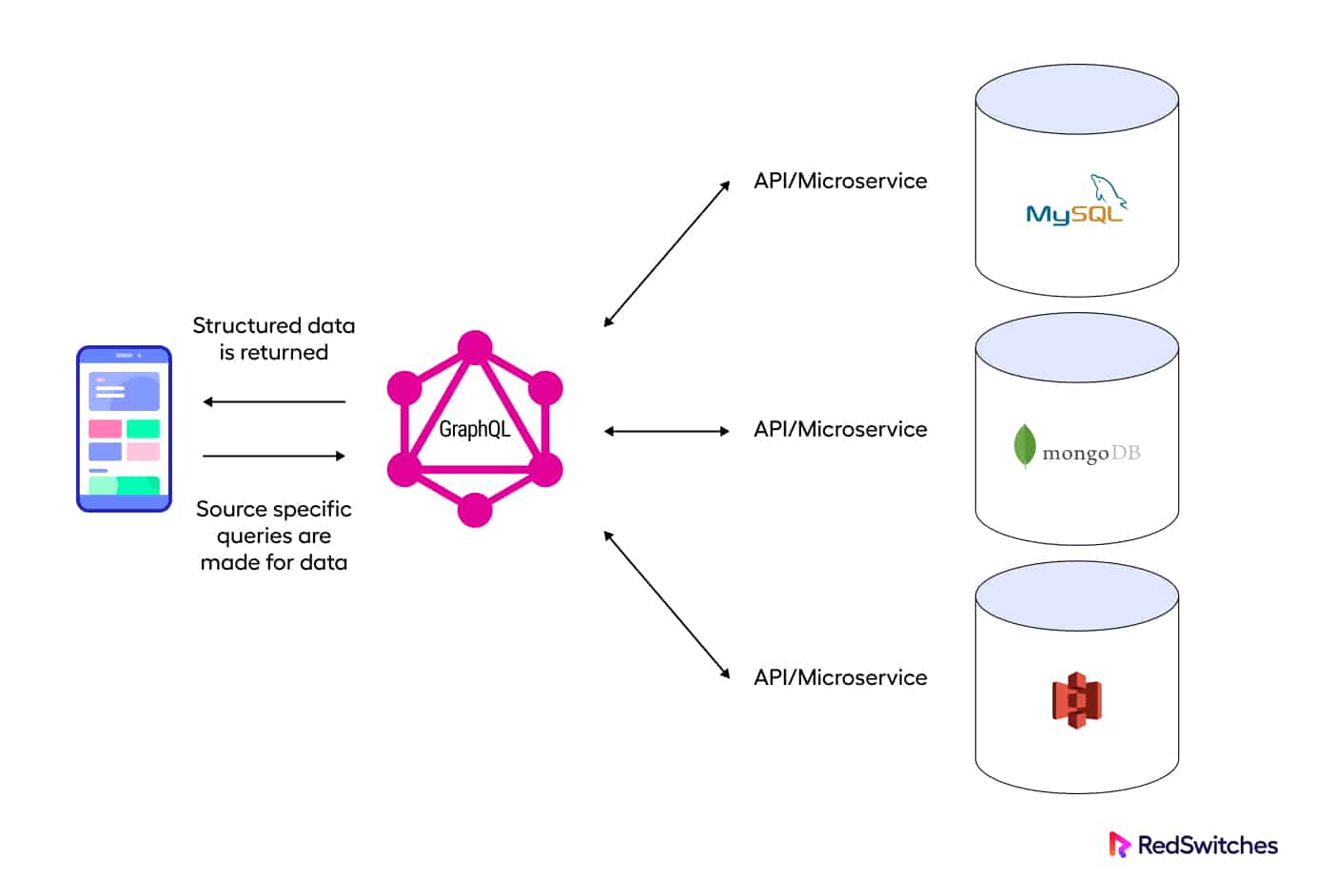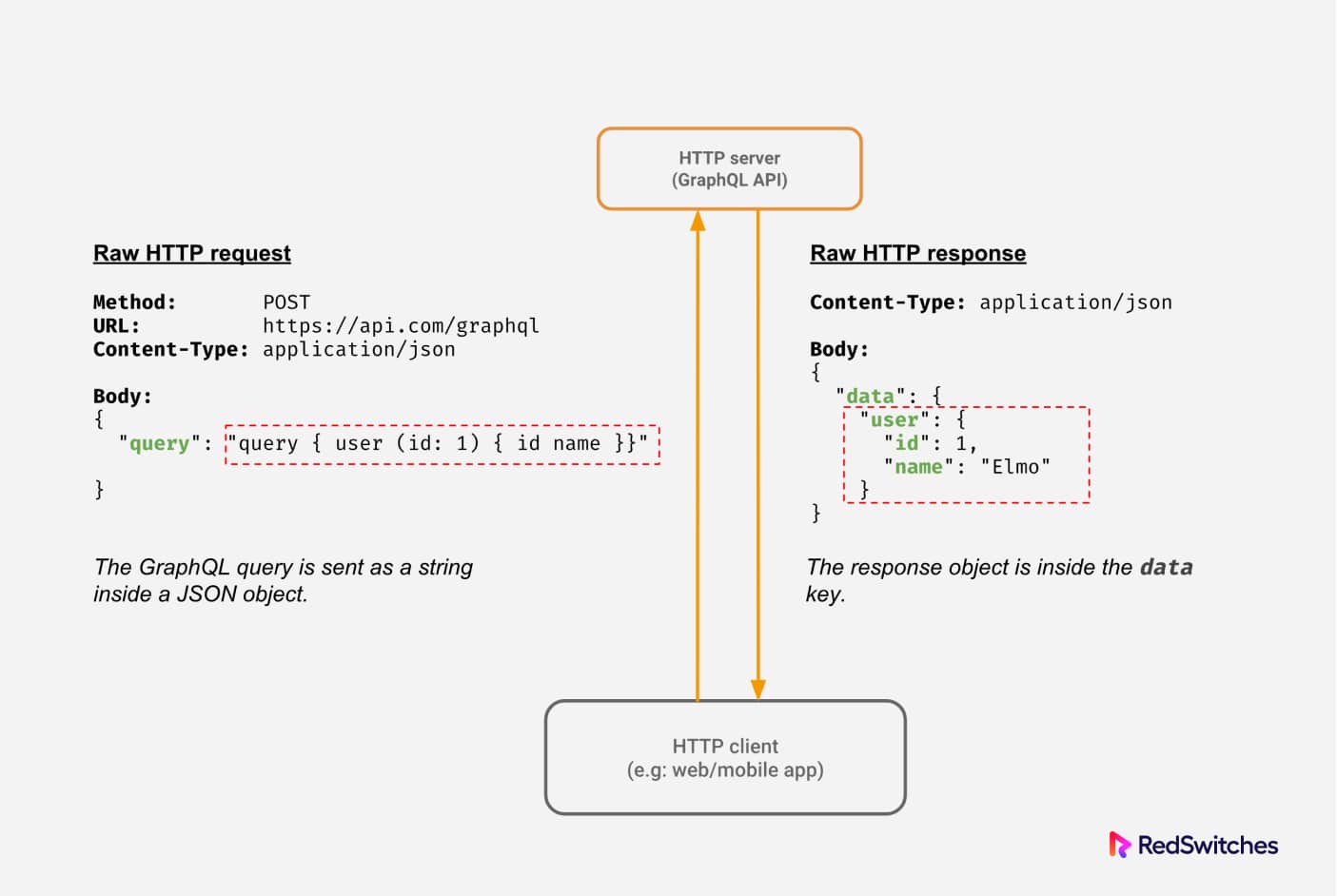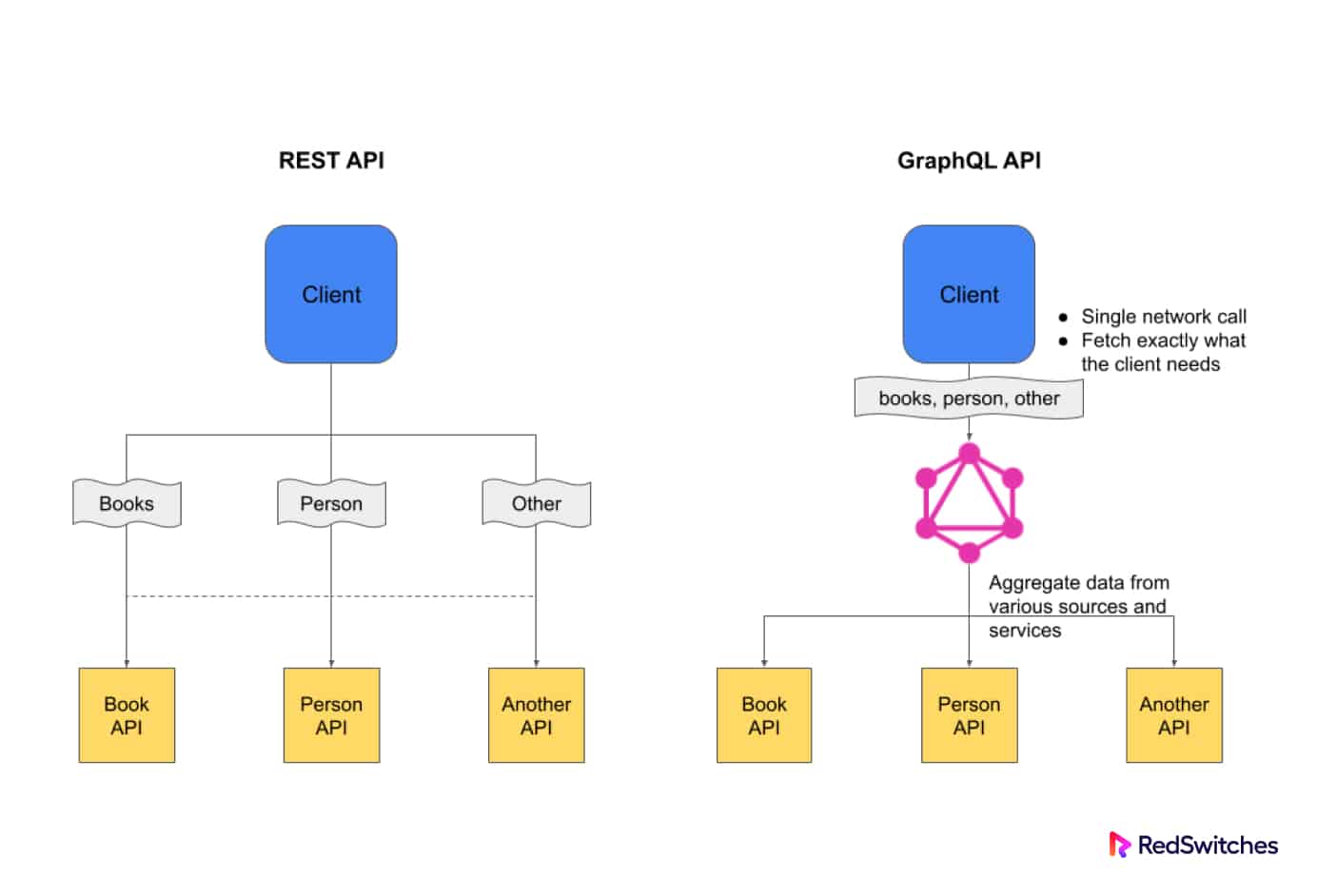This article discusses the various aspects of GraphQL vs REST API. We described the benefits, drawbacks and applications of both systems in detail for better decision makingModern software development heavily relies on Application Programming Interfaces (APIs) because they enable smooth communication among different software components, improving complex applications’ effectiveness.
When developing an app, determining the structure of your API is a crucial choice that affects everything from the app’s performance to scalability.
For several years, the preferred choice of developers has been REST. However, GraphQL’s adaptability and productivity have made it a popular choice for building app API. While each has its strengths and weaknesses, your choice can significantly impact your application’s success.
In this article, we’ll look at GraphQL vs REST, exploring how they differ and offering guidance on which to choose based on your specific needs.
The idea is to help you navigate the GraphQL vs REST debate and help you decide whether to opt for the traditional REST model or explore uncharted territory with newer alternatives like GraphQL.
Table Of Contents
- GraphQL vs REST: Understand the Basics
- What is REST?
- How RESTful APIs work?
- Features of REST API
- Application of REST API
- Advantages of REST API
- Disadvantages of REST API
- What is GraphQL?
- How Does GraphQL Work?
- Features of GraphQL
- Application of GraphQL
- Advantages of GraphQL
- Disadvantages-of-GraphQL
- Difference between GraphQL and REST API
- When to Use REST API?
- When to Use GraphQL?
- Conclusion
- FAQs
GraphQL vs REST: Understand the Basics
GraphQL and REST API are distinct “models” for building inter-application communication.
REST offers an architectural approach that leverages HTTP for data exchange, whereas GraphQL is a query language that enables you to obtain the required information without adding the overheads of wrappers.
Let’s start the GraphQL vs REST discussion by describing the fundamentals.
What is REST?
APIs enable the transfer of data between different software by following specific instructions.
A RESTful API, known as REST API, is an internet-based platform that conforms to the architecture of Representational State Transfer (REST).
The REST API implements a model of client-server architecture. Upon receiving a request, the server responds with the required data via HTTP requests. Every URL is considered a request, and the data transmitted back is considered a response.
REST API is stateless, meaning the server doesn’t store client state info. All necessary information for a request is included in the request itself. This allows for scalability and flexibility, as the server doesn’t need to maintain any state info about the client.
How RESTful APIs work
In practical terms, the operation of RESTful API can be divided into two processes to better understand how these API transfer data between clients and applications.
Client Request
A client is a program or person who accesses the services of the API. During this, a request is sent from the client to the server as a web URL as HTTP GET, POST, PUT, or DELETE request.
- GET – retrieve a resource.
- POST – create a new resource.
- PUT – edit or update an existing resource.
- DELETE – delete a resource.
Consider an app that connects to YouTube.
My app (the client) can ask YouTube’s REST API to get details of a particular video (a resource). The resource state will be returned in response to the request by the YouTube API, which contains details like the video name, publication date, view count, and URL. My app can also add a new resource (as a video) to my YouTube account using a POST request through the API.
Server Response
When a client uses a RESTful API to make a request, the server responds with a representation of the requested resource’s state, which can be in the form of HTML, XML, an image, or JSON. Out of these, JSON has become a de facto standard of information interchange using API and web services.
However, it’s important to note that the server doesn’t send the actual resource to the client. Instead, it sends a standardized representation of its state at the time the request was received. This ensures consistency and allows for easy communication between the client and server.
Features of REST API
REST architecture prioritizes specific principles to guarantee that APIs using this model are effortlessly scalable, highly accessible, and can be extended with ease.
These principles enable REST APIs to manage high traffic volumes and deliver reliable and effective service to users. Since they’re important to the REST API operations, let’s examine them in more detail:
Client-Server Architecture
The REST API is based on a client-server design that streamlines communication between a server and a client.
This design is typically used in modern web development to build effective and adaptable systems. By enabling the exchange of data via HTTP requests and responses, the REST API provides a versatile method of communication between the server and the client.
Statelessness
A REST API operates on a stateless mechanism, implying that every client request to the server includes all the required data to process the request without additional context or information.
This makes it a preferred option for writing web applications that need continuous data exchange between the client and server. Although this model may result in a huge volume of requests and responses, it allows the server to scale without storing state information for all received requests.
Cacheability
Cacheability in REST API refers to the ability of the API to store responses for requests and send the appropriate response back to clients in response to repeated requests.
By using a caching mechanism, the performance of an API can experience a noteworthy boost since it reduces the number of requests sent to the server.
Additionally, this approach also reduces the costs associated with processing and transmission of data. This cost-saving becomes more important for APIs that receive a huge volume of traffic due to the fact that each individual request within the REST-based architecture is equipped with both authentication tokens and relevant state information necessary for server action.
Layered System
REST APIs can be designed to be a layered system, where clients interact with an intermediate server that then interacts with the actual server containing the resource.
The approach allows application designers to introduce scalability within the system by adding a proxy or load balancer placed between the client and server.
The layered system architecture can also enhance app security by adding a separate layer dedicated to security.
From the client’s perspective, all the layers between them and the main server essentially don’t exist because they get the response to their requests without any delays.
Code-On-Demand (CoD)
Many developers consider this optional, as it can lead to unintended side effects and exploits.
When developers opt to integrate code-on-demand, the server may return a piece of executable code on the client’s demand (instead of sending back JSON representations).
CoD gives the client more control over the features and allows for extended functionality leading to more dynamic and customizable interactions.
Uniform Interface
The consistent interface of the REST API allows clients to communicate with the server in a “universal language” without any dependence on the underlying system components.
This interface must offer a consistent and standardized approach to communication between the client and the server. This can be achieved by using HTTP, URI resources, and the commonly used CRUD (Create, Read, Update, Delete) and JSON formats.
The four guiding principles of the uniform interface are;
- Identify resources: RESTful APIs must allow clients to specify a resource using a Uniform Resource Identifier (URI) that should be included in the request.
- Manipulation through representations: If both a resource and its corresponding metadata can be acquired, then the client should have the capability to alter or remove the said resource.
- Self-describing messages: The client should receive proper Instructions on how to manage a resource and its presentation.
- HATEOAS: In addition to providing a representation of the concerned resource, the server should provide the client with all information on additional actions the client can take or resources they can download.
Application of REST API
The REST API is utilized in numerous applications, primarily in creating mobile applications and web-based programs.
Its adaptability and versatility allow programmers to build and deliver expandable APIs that deliver real-time data to various devices.
REST API is widely utilized in creating eCommerce websites, allowing for the efficient management of product catalogs, orders, and expedited payment processing.
Social media platforms also implement REST API, allowing users (especially users on mobile devices) to access and engage with social media data.
Finally, REST API plays a vital role in cloud computing, facilitating communication between cloud services and supporting various web applications.
In short, REST API has a vast range of applications and is more adaptable to different uses. That’s why it has become one of the most popular web services architectures in software development.
Advantages of REST API
- You can scale your software effortlessly with REST API.
- The autonomy offered by the REST protocol enables independent development across different project components due to the division between the client and server.
- Developers commit to adhering to uniform standards while designing REST APIs, resulting in a uniform interface throughout all APIs.
- The client machine does not need any routing information.
- REST API supports various data formats like plain text, JSON, XML, and HTML.
- Easy to migrate from one server to another.
- Developers can experiment with different project environments during the development process.
- It is possible to generate process instances through explicit means.
Disadvantages of REST API
- The REST framework does not retain any previous interaction information between the client and server.
- Over-fetching and under-fetching can become problematic. REST APIs have fixed endpoints that return fixed data structures, which can result in over-fetching (retrieving more data than necessary) or under-fetching (not retrieving all the required data). This can result in inefficient use of network bandwidth and slower performance.
- RESTful API structure does not enforce data security measures like SOAP does. As a result, REST is better suited for public interactions rather than for confidential data exchange between a client and a server.
- Lack of a Standard: As REST APIs can be constructed in various ways, you must check each one from scratch as a developer to find the best fit for your project.
- It is impossible to manipulate resources that are nested.
- The validation of queries is not possible.
- It is incapable of handling API additions, deprecations, and changes.
What is GraphQL?
GraphQL is an open-source data query and manipulation language developed by Facebook.
It is a popular option for building API with Node.js or Ruby on Rails server-side frameworks and is gaining more traction among developers. It provides a more flexible and powerful way to interact with APIs, improving web and mobile applications’ performance and user experience.
By enabling clients to request just the required data without any excess information, GraphQL operates more efficiently compared to conventional REST APIs.
With GraphQL, clients can get the necessary data in a single request, thus eliminating the need for multiple round trips and reducing network traffic.
GraphQL comes with a type system that outlines the API’s structure, thereby simplifying the comprehension of the available data for developers.
Furthermore, it simplifies the process of updating APIs, as developers can modify data structure without impacting current users.
How Does GraphQL Work?
GraphQL is a language (with its own syntax) for interacting with APIs in order to access their data.
This language allows developers to precisely request the required data, resulting in the prevention of over-fetching or under-fetching data from API.
GraphQL operates by defining a schema that outlines the accessible data types and their interconnections. Clients use this schema to create queries to request the specific data they need.
When a GraphQL API receives a query from a client, it initiates validation to confirm that the desired data exists. If the query is valid, the API retrieves the requested data and encloses it in a JSON object before sending it back to the client.
This strategy allows a single API to service several clients with customized data requirements. This boosts efficiency and reduces network consumption.
Due to its adaptability, efficiency, and user-friendly nature, GraphQL has quickly emerged as a preferred option for constructing APIs. It is utilized by top-notch organizations like GitHub, Shopify, and Airbnb to enable their APIs and allow developers to benefit from cutting-edge API conveniences.
Features of GraphQL
Let’s dive into some prominent features of GraphQL:
Typed schema
GraphQL leverages a robust type system to establish an API’s functionalities. The GraphQL Schema Definition Language (SDL) is utilized to document all the types accessible within an API’s schema. This schema functions as the agreement between the server and the client, outlining the client’s ability to request data.
Efficient queries
GraphQL empowers clients to precisely define the data they need, resulting in reduced data exchange across the network and improved efficiency.
Hierarchical queries
The manner in which GraphQL inquiries are organized facilitates a hierarchical approach, enabling clients to define nested data architecture and minimizing the requirement for several round-trip demands.
Multiple resources in a single request
GraphQL allows clients to retrieve data from multiple sources with a single request. , thereby reducing the necessity of making numerous requests. This reduces the toll on the servers and speeds up application performance.
Real-time data
GraphQL provides the ability for real-time data updates through the use of subscriptions. This allows clients to receive continuous updates as the data changes at the source.
Language Agnostic
GraphQL is incredibly flexible and adaptable since it isn’t restricted to one particular programming language or framework.
Declarative data fetching
GraphQL allows clients to declare what data they need. The server is responsible for returning the data in the requested format, making writing and maintaining client-side code easier.
Schema Introspection & Documentation
Developers can easily interact with GraphQL APIs as they can query the schema during runtime, resulting in a self-documenting system that provides essential information for writing properly formatted queries.
Application of GraphQL
GraphQL is a versatile tool with numerous applications for developing flexible and effective APIs.
The beauty of GraphQL lies in its relevance in client-facing APIs, as it enables clients to request data that they actually require, thereby reducing network usage and enhancing performance. Developers mostly use GraphQL in web and mobile apps as it allows for easy data management from multiple sources.
GraphQL is famous for manipulating and retrieving API data due to its seamless integration with web and mobile applications. It’s especially remarkable in developing real-time applications with complex multilevel data structures because developers can structure the requests to ask only for the data that they need. This prevents over-fetching of data that could complicate response parsing.
Another benefit of GraphQL is that developers can write a single request to get consolidated information from multiple sources into a developer-friendly API.
Advantages of GraphQL
- Since it’s strongly typed, GraphQL executes its queries within the particular context of the system.
- The language offers a declarative approach to querying that allows developers to write a precise description of their requirements.
- The client, rather than the server, encodes queries in GraphQL.
- GraphQL offers queries that are human-readable.
- You can tailor the requests to your needs by providing the description.
- With GraphQL, the documentation is generally updated automatically to match any modifications made to the API.
- Beneficial for caching and combining query responses.
- Facilitates quick creation of application prototypes.
- Incorporates characteristics found in the application layer of the OSI model.
- Enables the identification of schema in a suitable format.
- Evolution of API without versioning.
Disadvantages of GraphQL
- Performance issues with complex queries. Although GraphQL queries offer the ability for clients to ask for specific requests, the performance of the query may suffer if the client requests multiple nested fields simultaneously.
- It could be “too much” for small applications. It could make things more complicated for basic applications, hence not being an ideal solution.
- No caching mechanisms that allow for the retention of request content.
- Prior to deploying any GraphQL approaches, you must acquire proficiency in the GraphQL Schema Definition Language.
- File uploading is not supported as GraphQL is not equipped to handle files. In REST, you can submit any desired content through the use of POST or PUT.
Difference between GraphQL and REST API
The most significant contrast between GraphQL and REST lies in the approach to transmitting data to the client.
In REST, the client initiates an HTTP request and receives data as an HTTP response, whereas in GraphQL, data is requested by the client through queries.
Here is a detailed comparison of the two API structures:
Architecture
GraphQL mainly works on the server side of an application because it’s designed for executing queries with existing data in a client-driven architecture. In contrast, REST is an architectural style for software that sets constraints for creating web services in a server-driven architecture.
Data retrieval
REST APIs are resource-oriented and provide fixed endpoints to retrieve data. Clients make requests to specific endpoints and receive data in a predefined structure.
GraphQL APIs are query-based and allow clients to request the exact data they need using a declarative approach. The server returns the requested data in the format defined by the client.
Data structure
REST APIs have a predetermined data structure for a particular endpoint that may or may not be suitable for every client. Many clients receive redundant or unnecessary data or must execute multiple requests to acquire all the required information.
GraphQL APIs, in contrast, permit clients to request only the necessary data and specify the response format. Consequently, it is far more flexible, efficient, and simple to scale these queries over time.
Network efficiency
REST APIs may necessitate numerous requests for the complete retrieval of the required information, leading to network congestion and service overheads. This could become a serious issue when bandwidth is restricted. On the other hand, GraphQL APIs can acquire all the needed data in one request, minimizing network overhead and enhancing performance.
Versioning
When making changes to REST APIs, it is important to implement versioning as the structure of the response is controlled by the clients. This can create challenges in evolving the API without disrupting clients. In contrast, GraphQL APIs enable clients to specify the structure of the response, facilitating smoother API evolution and minimizing the need for versioning.
Tooling
GraphQL offers easy code generation, documentation, and introspection with rich tools and a robust type system. This results in improved productivity for developers and facilitates the development and upkeep of APIs. Conversely, REST APIs may need additional work to achieve comparable performance.
Backend complexity
GraphQL APIs require a more complex backend implementation than REST APIs because the server must handle dynamic queries and data structures. This can make it more difficult to build and maintain GraphQL APIs.
REST APIs have a simpler backend implementation, as they provide a fixed structure for the data.
When to Use REST API?
REST APIs are well-suited for resource-oriented scenarios, where the client needs to retrieve or manipulate a fixed set of resources. Examples of such scenarios include CRUD operations (create, read, update, delete) on a database or file system.
REST API is your go-to solution if you require fast access to a substantial volume of data. It is particularly advantageous when dealing with various data types, as each request can be modified to retrieve just the required data in the desired format.
Furthermore, REST APIs are more commonly used and standardized, which makes configuration faster and simpler than GraphQL APIs.
In addition, REST is an excellent choice when there is a requirement for setting up a cache for a high volume of repeated requests. By incorporating a cache, the previously proceeded responses to the most common queries are stored in an intermediary solution (generally a proxy server).
When a client sends in a request for a resource, the cache is checked first. If the response/resource is present, the request isn’t forwarded to the server. Adopting a caching solution can reduce the number of trips made to the server (and thus the load on the server).
When to Use GraphQL?
GraphQL proves to be a better option when you need precision in the requested data from the server.
GraphQL offers a concise endpoint that delivers all requested data in a single response. Furthermore, GraphQL offers flexibility in data manipulation where clients can take advantage of the complex relationships between different data types.
GraphQL is specifically created to function seamlessly with various data sources, which is ideal for situations where data is distributed across multiple databases or systems. Using GraphQL, users can gather information from multiple sources through a single query.
GraphQL also offers the inherent capability to facilitate real-time updates. That’s why It is a great fit for scenarios where end-users must receive real-time updates as and when data changes. Clients can “subscribe” to specific sources via GraphQL queries and get immediate updates without having to do continuous polling.
Conclusion
This article provides a comprehensive overview of the GraphQL vs RESTful APIs debate. We covered the merits and drawbacks to assist you in making an informed decision about which API option suits your preferences the best.
Following in the footsteps of RESTful API architectural patterns, GraphQL is a cutting-edge technology that promises faster responses, a unified API endpoint for all queries, and a “rigid” schema for consistent data access. This has led many multi-billion-dollar companies to embrace GraphQL. Nevertheless, REST, the parent of GraphQL, still holds a dominant position in app development.
FAQs:
Q-1) What is the difference between GraphQL and REST?
GraphQL is a language used for querying data where clients define the exact data they want to receive from the server, while REST is a design pattern that employs HTTP wrappers to access and control resources. REST typically has fixed endpoints that are linked to particular resources, whereas GraphQL only has one endpoint and clients can obtain any desired data combination by querying this end.
Q-2) What are REST APIs?
RESTful APIs follow the REST architecture and allow clients to interact with server resources via established HTTP methods like GET, POST, PUT, and DELETE. These APIs have a set of predetermined endpoints arranged based on specific resources like users, products, or articles.
Q-3) What is a REST API endpoint?
A REST API endpoint refers to a link through which a client accesses a server resource. These endpoints are typically designed around specific resources and allow for standard HTTP operations, such as GET, POST, PUT, or DELETE. Clients have the ability to interact with various server resources by utilizing multiple endpoints.
Q-4) What are GraphQL APIs?
GraphQL APIs utilize the GraphQL query language to enable clients to fetch data from a server. Unlike REST, which has predetermined endpoints, GraphQL features a single endpoint that lets clients request any desired data combination with a single query.
Q-5) What is a GraphQL query?
A GraphQL API receives requests for particular information through GraphQL queries. These queries enable clients to precisely define the data they want and obtain only that data as a response. Additionally, queries can incorporate parameters to refine and arrange the data in the desired format.
Q-6) What are the advantages of using GraphQL?
Using GraphQL offers several benefits such as the ability to reduce network requests by allowing clients to fetch all essential data in a single request and improved versioning and deprecation, enabling clients to adjust to any changes.
Q-7) Which companies use GraphQL or REST API?
A lot of businesses utilize both GraphQL and REST API. Prominent businesses that employ GraphQL include Facebook, GitHub, and Shopify. Meanwhile, Twitter, Google, and Amazon are among the companies that utilize REST API.
